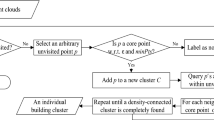Abstract
This paper presents a new algorithm for building extraction from LIDAR (Light Detection and Ranging) point cloud data on the basis of a marked point process based building model. In this building model, the positions and geometries of buildings are modeled by a point process and its marks, respectively. The geometric marks for buildings include their length, width, direction, height. By Bayesian paradigm, a posterior distribution for the marked point process conditional on the LIDAR point cloud data is obtained. The Reversible Jump Markov Chain Monte Carlo (RJMCMC) based scheme is designed to simulate the posterior distribution. Finally, Maximum A Posteriori (MAP) strategy is used to obtain the optimal building detection. The proposed algorithm is tested by a set of LIDAR point cloud data. The results show its efficiency in complex residential environments.







Similar content being viewed by others
References
Antonarakis, A. S., Richards, K. S., & Brasington, J. (2008). Object-based land cover classification using airborne LIDAR. Remote Sensing of Environment, 112(6), 2988–2998.
Awrangjeb, M., & Zhang, C. (2012). Building detection in complex scenes thorough effective separation of buildings from trees. Photogrammetric Engineering & Remote Sensing, 78(7), 729–745.
Baltsavias, E. P. (1999). Airborne laser scanning: existing systems and firms and other resources. ISPRS Journal of Photogrammetry and Remote Sensing, 54(2–3), 164–198.
Besag, J. E., Green, P., Higdon, D., & Mengersen, K. (1995). Bayesian computation and stochastic systems (with discussion). Statistical Science, 10(1), 3–66.
Descombes, X., & Zerubia, J. (2002). Marked point process in image analysis. IEEE Signal Processing Magazine, 19(5), 77–84.
Dryden, I. L., Scarr, M. R., & Taylor, C. C. (2003). Bayesian texture segmentation of weed and crop image using reversible jump Markov chain Monte Carlo methods. Journal of the Royal Statistical Society, Series C (Applied Statistics), 52(1), 31–50.
Filin, S. (2004). Surface classification from airborne laser scanning data. Computers and Geoscience, 30(9–10), 1033–1041.
Gamba, P., & Houshmand, B. (2000). Digital surface models and building extraction: a comparison of IFSAR and LIDAR data. IEEE Transactions on Geoscience and Remote Sensing, 38(4), 1959–1968.
Green, J. (1995). Reversible jump Markov chain Monte Carlo computation and Bayesian model determination. Biometrika, 82(4), 711–732.
Hartvig, N. V. (2002). A stochastic geometry model for function magnetic resonance images. Scandinavian Journal of Statistics, 29(3), 333–353.
Lafarge, F., Gimelfarb, G., & Descombes, X. (2010). Geometric feature extraction by a multi-marked point process. IEEE Transaction on Patten Analysis and Machine Intelligence, 32(9), 1597–1609.
Maas, H. G. (1999). Fast determination of parametric house models from dense airborne laser scanner data. International Archives of Photogrammetry and Remote Sensing, 32(B3), 1–6.
McLachlan, G., & Peel, D. (2000). Finite mixture models. New York: John Wiley and Sons.
Morgan, M., & Habib, A. (2001). 3D TIN for automatic building extraction from airborne laser scanner data. In Proceedings of ASPRS Congress, Gateway to the New Millennium, St. Louis, Missouri.
Morgan, M., & Tempfli, K. (2000). Automatic building extraction from air-borne laser scanning data. International Archives of Photogrammetry and Remote Sensing, 33(B3), 616–623.
Ortner, M., Descombes, X., & Zerubia, J. (2007). Building outline extraction from digital elevation models using marked point processes. International Journal of Computer Vision, 72(2), 107–132.
Ortner, M., Descombes, X., & Zerubia, J. (2008). A marked point process of rectangles and segmentation for automatic analysis of digital elevation models. IEEE Transaction on Patten Analysis and Machine Intelligence, 30(1), 105–119.
Overby, J., Bodum, L., Kjems, E., & Ilsϕe, P. M. (2004). Automatic 3D building reconstruction from airborne leaser scanning and cadastral data using Hough transform. Archives of Photogrammetry, Remote Sensing and Spatial Information Sciences, 34(B3), 296–301.
Quartulli, M., & Datcu, M. (2004). Stochastic geometrical modeling for built-up area understanding from a single SAR intensity image with meter resolution. IEEE Transactions on Geoscience and Remote Sensing, 42, 1996–2003.
Rottensteiner, F. (2003). Automatic generation of high-quality building models from LIDAR data. IEEE Computer Graphics and Application, 23(6), 42–50.
Rue, H., & Hurn, M. A. (1999). Bayesian object identification. Biometrika, 86(3), 649–660.
Sampath, A., & Shan, J. (2007). Building boundary tracing and regularization from airborne LIDAR point cloud. Photogrammetric Engineering and Remote Sensing, 73(7), 805–812.
Schabenberger, O., & Gotway, C. A. (2005). Statistical methods for spatial data analysis. Boca Raton: Chapman and Hall/CRC.
Stoyan, D., Kendall, W. S., & Mecke, J. (1995). Stochastic geometry and its applications (2nd ed.). New York: John Wiley and Sons.
Vosselman, G. (2001). Building reconstruction using planar faces in very high density height data. International Arches on Photogrammetry and Remote Sensing, 34(B3), 211–218.
Vu, T. T., Yamazaki, F., & Matsuoka, M. (2009). Multi-scale solution for building extraction from LIDAR and image data. International Journal of Applied Earth Observation and Geoinfomation, 11(4), 281–289.
Winkler, G. (1995). Image analysis, random field and Markov Chain Monte Carlo methods a mathematical introduction. Springer.
Zhang, K., Yan, J., & Chen, S. C. (2006). Automatic construction of building footprints from airborne LIDAR data. IEEE Transactions on Geoscience and Remote Sensing, 44(9), 2523–2533.
Zhao, W., Cheng, L., & Tong, L. (2011). Robust segmentation of building points from airborne LIDAR data and imagery. 19th International Conference on Geoinformatics, 24–26, June, 2011.
Zhou, Q. Y., & Neumann, U. (2013). Complete residential urban area reconstruction from dense aerial LIDAR point clouds. Graphical Models, 75, 118–125.
Author information
Authors and Affiliations
Corresponding author
About this article
Cite this article
Zhao, Q., Li, Y. & He, X. Building Extraction from LIDAR Point Cloud Data Using Marked Point Process. J Indian Soc Remote Sens 42, 529–538 (2014). https://doi.org/10.1007/s12524-013-0358-0
Received:
Accepted:
Published:
Issue Date:
DOI: https://doi.org/10.1007/s12524-013-0358-0




